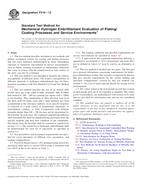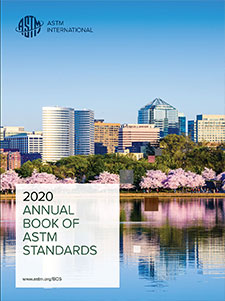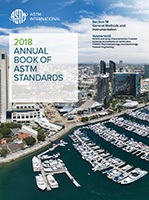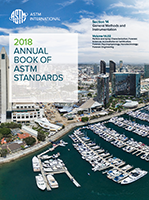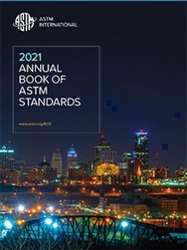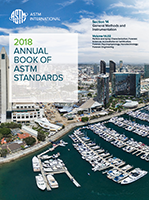Description
1.1 This test method describes mechanical test methods and defines acceptance criteria for coating and plating processes that can cause hydrogen embrittlement in steels. Subsequent exposure to chemicals encountered in service environments, such as fluids, cleaning treatments or maintenance chemicals that come in contact with the plated/coated or bare surface of the steel, can also be evaluated.
1.2 This test method is not intended to measure the relative susceptibility of different steels. The relative susceptibility of different materials to hydrogen embrittlement may be determined in accordance with Test Method F1459 and Test Method F1624.
1.3 This test method specifies the use of air melted AISI E4340 steel per SAE AMS-S-5000 (formerly MIL-S-5000) heat treated to 260 – 280 ksi (pounds per square inch x 1000) as the baseline. This combination of alloy and heat treat level has been used for many years and a large database has been accumulated in the aerospace industry on its specific response to exposure to a wide variety of maintenance chemicals, or electroplated coatings, or both. Components with ultimate strengths higher than 260 – 280 ksi may not be represented by the baseline. In such cases, the cognizant engineering authority shall determine the need for manufacturing specimens from the specific material and heat treat condition of the component. Deviations from the baseline shall be reported as required by section 12.1.2. The sensitivity to hydrogen embrittlement shall be demonstrated for each lot of specimens as specified in section 9.5.
1.4 Test procedures and acceptance requirements are specified for seven specimens of different sizes, geometries, and loading configurations.
1.5 Pass/Fail Requirements – For plating/coating processes, specimens must meet or exceed 200 h using a sustained load test (SLT) at the levels shown in Table 3.
1.5.1 The loading conditions and pass/fail requirements for service environments are specified in Annex A5.
1.5.2 If approved by the cognizant engineering authority, a quantitative, accelerated (≤ 24 h) incremental step-load (ISL) test as defined in Annex A3 may be used as an alternative to SLT.
1.6 This test method is divided into two parts. The first part gives general information concerning requirements for hydrogen embrittlement testing. The second is composed of annexes that give specific requirements for the various loading and specimen configurations covered by this test method (see section 9.1 for a list of types) and the details for testing service environments.
1.7 The values stated in the foot-pound-second (fps) system in inch-pound units are to be regarded as standard. The values given in parentheses are mathematical conversions to SI units that are provided for information only and are not considered standard.
1.8 This standard does not purport to address all of the safety concerns, if any, associated with its use. It is the responsibility of the user of this standard to establish appropriate safety and health practices and determine the applicability of regulatory limitations prior to use.
TABLE 1 Lot Acceptance Criteria for Notched Specimens
| Type | Item | Sampling of Each Lot |
Requirement/Method |
|---|---|---|---|
| 1 | Tensile Strength | 4 each | Test Method E8. Tensile strength of each specimen must be within 10 ksi of the average. |
| 1 | HardnessA | 5 % | 51 to 53 HRC per Test Methods E18. Round the average of three readings per specimen per Practice E29. |
| 1 | Dimensions | 100 % | Meet tolerances of corresponding drawings. Notch dimension verified with shadow graphic projection at 50 to 100× or equivalent. |
| 1 | Notched Fracture Strength (NFS) | 10 ea | Test Methods E8. NFS of each specimen must be within 10 ksi of the average. |
| 1c | Self-loading notched round specimen bend fixture, Fig. A2.7 |
10 ea | Alternate: The number of turns of the loading bolt, which is required to produce fracture in each specimen, must be within 5 % of the average. |
| 1d | Self-loading notched C-Ring bend fixture, Fig. A2.8 |
10 ea | Alternate: The change in diameter at fracture load for each specimen must be within 0.008 inches of the average. |
A If the hardness requirements of any of the sampled specimens are not satisfied, only those specimens of the lot that are individually inspected for conformance to these requirements shall be used for testing.
TABLE 2 Electroplating Bath Compositions and Operating Conditions for Sensitivity Test
| Item | Treatment A | Treatment B | |
|---|---|---|---|
| Bath composition: | Range | Optimum | |
| Cadmium (as CdO) | 2.9 to 5.5 oz/gal (22 to 41 g/L) | 4.5 oz/gal (33.7 g/L) | same as Treatment A |
| Total Sodium cyanide (NaCN) |
12.0 to 16.0 oz/gal (89.9 to 120 g/L) | 14 oz/gal (104 g/L) | same as Treatment A |
| Ratio NaCN to CdO | 2.8/1 to 6.0/1 | 3.0/1 | same as Treatment A |
| pH | 12.0 or greater | 12.0 | same as Treatment A |
| Temperature | 70–90°F (21–32°C) | 75°F (24°C) | same as Treatment A |
| Sodium hydroxide (NaOH)A |
1.0 to 3.2 oz/gal (7.5 to 24.0 g/L) | 2.5 oz/gal (18.7 g/L) | same as Treatment A |
| Brightener such as Colcad 100B or equivalent |
Manufacturer's suggested range | None | |
| Electroplating current | 10 A/ft2 (108 A/m²) | 60 A/ft2 (645 A/m 2) | |
| Electroplating time | 30 minutes | 6 minutes | |
| Baking | |||
| Baking temperature | 375 ± 25°F (190 ± 14°C) | same as Treatment A | |
| Baking time: Type 1 Specimen |
Do Not Bake | 23 h | |
| Baking time: Type 2a Specimen |
8 h | 23 h | |
| Chromate TreatmentC | Yes | same as Treatment A | |
A Addition of sodium hydroxide may not be required on solution makeup, since the addition of 1 oz/gal of cadmium oxide is equivalent to 0.6 oz/gal of free hydroxide.
B The sole source of manufacture of Colcad 100 known to the committee at this time is Columbia Chemical in Brunswick, Ohio, www.columbiachemical.com. If you are aware of alternative manufacturers, please provide this information to ASTM International Headquarters. Your comments will receive careful consideration at a meeting of the responsible technical committee, which you may attend.
C After baking, the specimens shall be dipped into any appropriate chromate conversion coating solution for minimum time that will produce an adherent and continuous coating as described in AMS-QQ-P-416 Type II.
TABLE 3 Pass/Fail Loading Requirements of Test Specimens
| Type 1a, 1b, 1c, 1d, 1e | 75 % of the tensile or bend NFS (Table 1). |
| Type 2a | 92 % of the Test Methods E8, E4 ultimate strength, obtained by deflecting a 2.300-inch diameter O-Ring specimen with a 2.525-inch stressing bar. |
Product Details
- Published:
- 06/01/2012
- Number of Pages:
- 18
- File Size:
- 1 file , 240 KB
- Redline File Size:
- 2 files , 420 KB

